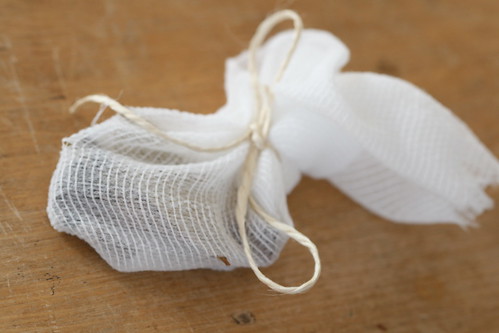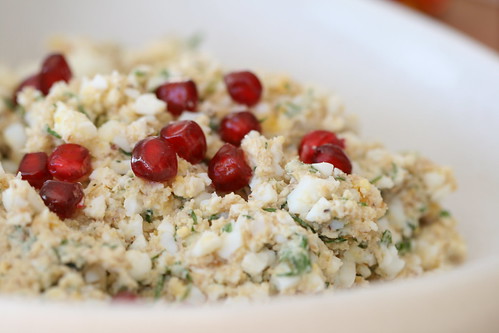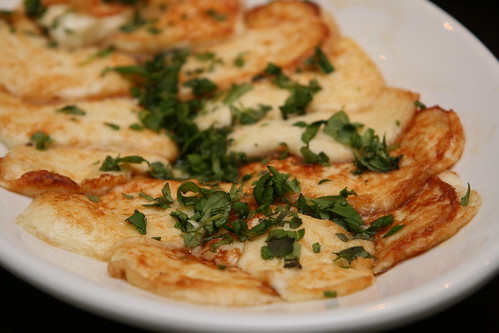|
|
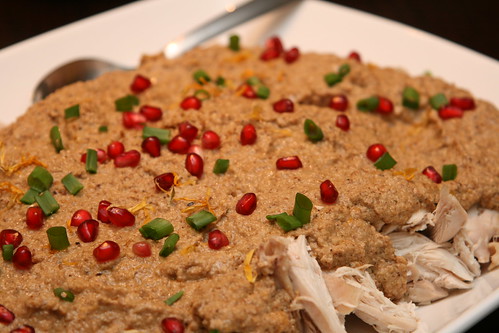
Melissa of
The Traveler's Lunchbox posted a
recipe for Georgian spinach pkhali last week and I got an immense craving for Georgian dishes again. I've been cooking quite a few of them for various reasons - there were some Georgian cooking classes I gave back in 2008 and 2009, there have been Georgian midweek feasts at our home, there are recipes to re-test and re-write for yet another cookbook project ;) But apparently while I've been cooking all those delicious Georgian dishes, I've failed to share the recipes with you, dear readers. I'll try to rectify that shortcoming a.s.a.p., starting as of today. To start with (and that is a 6th
Georgian recipe @ Nami-Nami), I'll give you a recipe for a really lovely and unusual chicken dish.
Georgians love walnuts - they are one of the few people who use walnuts as a main ingredient in the kitchen, not just as a garnish here and there - and they do that pretty much on a daily basis. One of the most well-known and popular uses for walnuts is in
satsivi sauce, which can be served with chicken, fish and vegetables (
aubergine/eggplant satsivi is another very popular dish). There is no one recipe for satsivi - apparently there are at least 20 different versions - and that does not count the secret versions of all individual Georgian cooks! The name '
satsivi' comes from the Georgian word '
tsivi', meaning 'cold/cool' - and it illustrates the fact that a warm satsivi sauce is spooned over a cooked chicken and left to cool and marinate the chicken. Because of that, it's strictly a cold-weather dish. Nobody would pour hot sauce over cold chicken and leave it like that on a hot summer day - it's a health hazard. For hot summer days there are other chicken and walnut dishes (you'll find a recipe both for
katmis bazhe and
chkmeruli in Darra Goldstein's
Georgian cookbook). If you're interested in the fish satsivi, look out for it in Claudia Roden's excellent book on
Jewish cuisine.
Trust me - it's a lot easier to make than it sounds - and the end result is totally worth it!
Georgian Chicken in Walnut Sauce(
Kana-satsivi ehk Gruusia-pärane kana kreeka pähkli kastmes)
Serves six to eight
1 large free-range chicken
1 onion, peeled
2 bay leaves
some parsley stalks
salt
about 1.5 litres of water
Satsivi-sauce:3 Tbsp sunflower oil
2 large onions, finely chopped
250 g walnuts
6 garlic cloves
1.5 tsp ground cinnamon
0.5 tsp ground cloves
1.5 tsp ground coriander seeds
2 tsp dried marigold leaves
1 tsp freshly ground black pepper
1 tsp paprika powder
0.5 to 1 tsp Cayenne'i pepper or chilli flakes
a pinch of dried savory
0.5 to 1 tsp salt
3 Tbsp white wine or cider vinegar
about 1 litre chicken stock
Heat the oven to 200 C/400 F.
Place the chicken into a saucepan, pour over enough water to cover. Bring into a boil, removing all the froth that appeares on the surface. Then add the peeled onion, bay leaves and some salt. Reduce heat and simmer on a low heat for about 30 minutes.
Remove the chicken from the saucepan and place onto a deep oven dish, "face down". Add half a cup of boiling liquid. Roast in the middle of a 200C/400F oven for about 20-30 minutes, until the chicken is cooked.
Remove the chicken from the oven and let it rest for about 10-15 minutes.
Then you've got two options. Traditionally the chicken is cut into about 8-10 pieces and these are arranged on a serving tray. I've served this dish to a larger group of people and then it's more convenient (for the eaters, that is) to remove the flesh from the bones and cut into large bite-sized pieces, like this:
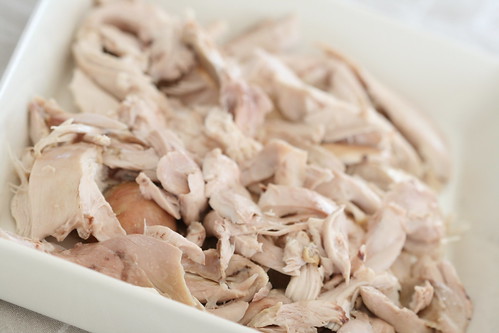
While the chicken is cooking in the oven, you should
1) Reduce the chicken stock - you'll need about 1 litre
2)
Prepare the satsivi-sauce:Chop the walnuts and garlic cloves in the food processor - you'll want small crumbs, but not a powder!!
Heat oil on a heavy frying pan. Add the chopped onion and sauté for 7-8 minutes.
Add the walnut mixture and fry, stirring all the time, for 3-4 minutes.
Return it all to the food processor and process into a thick coarse paste.
Now - return it to the pan again and add all the seasoning (except wine vinegar):
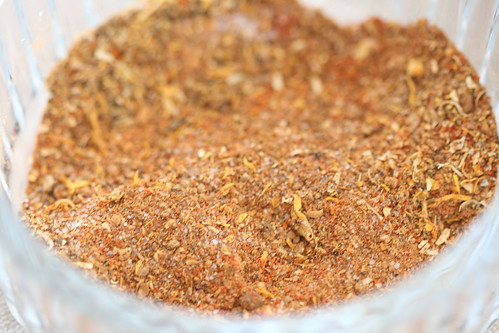
Fry for a few minutes, stirring carefully. Now start adding the chicken stock, ladleful at the time (you may not need all the stock - it depends on the thickness of your walnut paste - I've used anything from 3 to 4 cups). Let the sauce simmer for about 20 minutes over a low heat, until it thickens.
Season with wine vinegar and again with some salt and pepper, if necessary.
Pour the satsivi sauce over the chicken pieces and let cool to room temperature. Serve at room temperature, garnish with pomegranate seeds or parsley or cilantro leaves.
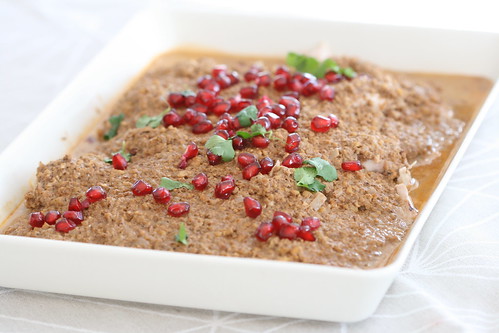
- Follow RecipesDream








